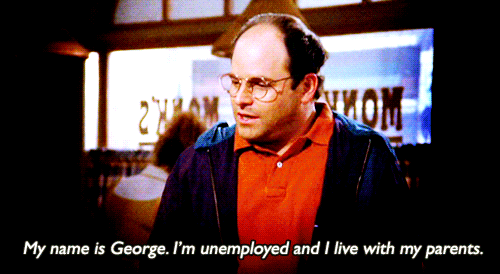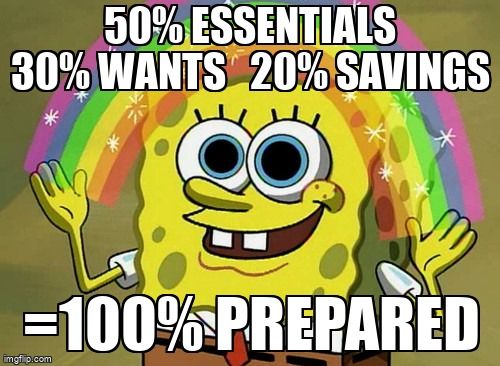Step 1: Try Living With Your Parents

Typically not a fan-favorite pick, and not an option for everyone, but it's cost-effective! Immediate pros include saving money on common expenses:
Rent/utility bills
Grocery bills
Renovations
This will free up your budget, giving you the flexibility to pay off any outstanding debt and sure, finally buy that one thing you've had your eye on for ages.
Additional bonuses may include:
Less housework & more home-cooked meals
Quality time with your parents
Did you know?
Step 2: Move Out And Build A Budget
Okay, so you tried living with your parents, and maybe you hated it. Or you loved it! But even so, you're ready to move out and stop introducing yourself like this:

You'll need to up your budget game! More freedom means more responsibility.
Step 3: Start With The Essentials
Where to start?
Getting as close to a 50/20/30 breakdown as possible is a good starting point to make sure you're covered on a month-to-month basis.
Breakdown of your take home pay:
50% — The Essentials: rent, groceries, utilities, commuting costs, childcare, etc.
30% — Treat Yourself/The Wants: entertainment, eating out, clothing etc.
20% — Savings/Debt Repayment: putting a small amount aside every month for emergencies or unexpected future expenses will be a lifesaver in the future!

Quiz
What would NOT fall into the 50% of your take home pay category?
A gym membership would fall into the 30% of your take home pay category, since it's a want. Think about it this way: if you needed to save money for a month could you survive if you cut it out of your budget?
Step 4: Define Your Wants
After the essentials are taken care of, it's time to figure out how best to spend your remaining cash.
On a tight budget, this typically means choosing what matters most to you.

So how do you choose?
We all have passions in life. Are you a foodie? A gamer? A stylist? An athlete? Budgeting luckily doesn't mean you can't do the things you want, it just means you have to figure out how and when you can do them.
Write out a list of things you believe you want and divide them into sections: Short Term (for things you can do anytime) and Long Term (for things you need to save up for). Here's an example if you're working with about $500 of disposable income per month:
Short Term
1x a week: Trivia Thursdays (with burgers and drinks) - $30
2x a week: Starbucks (just basic coffee, no fancy lattes) - $7
1x a week: Movie theater - $20
1x a month: Hair products - $20
Long Term
New Xbox: $500 (save $100 a month for 5 months)
New bag: $200 (save $50 a month for 4 months)
Used bike: $150 (save $75 a month for 2 months)

After you make your list, look at it with fresh eyes (maybe after a break) and figure out what you can and can't swing.
If your disposable income allows you to keep all your short term expenses while saving up for your long term expenses — wow, you already nailed it!
If you can afford all the short term expenses, but there's no room to save up for long term expenses — hold off on some short term stuff to save up for some big ticket items later on.
Step 5: Plan Ahead And Stick To The Script
Though no one would care to admit it, the hardest part of the budget is following it.

Once you've planned out what you expect to spend and save on a weekly basis, unplanned expenses can lower the funds available for everything else.
Stay strong and consider the opportunity cost of any unexpected activities or payments! Sure, you should absolutely grab drinks with John (if he ever finally asks), but make sure you consider how much cash that'll leave you for lunch the next day, or long term expenses in general.
Take Action

Your 50/30/20 budget is a great foundation, but it isn't set in stone. Plans change and you need to expect the unexpected.
As long as you stick to the overall budget, and adjust the finer points as needed, you should be able to lead a balanced life without sacrificing the things that make it worth living!
This Byte has been authored by
Jenny Qiu
Associate
Maddie Ryan
Associate
Tony Moffa
PwC DAT Experienced Associate
Matt Costanzo
Risk Assurance Senior Associate
